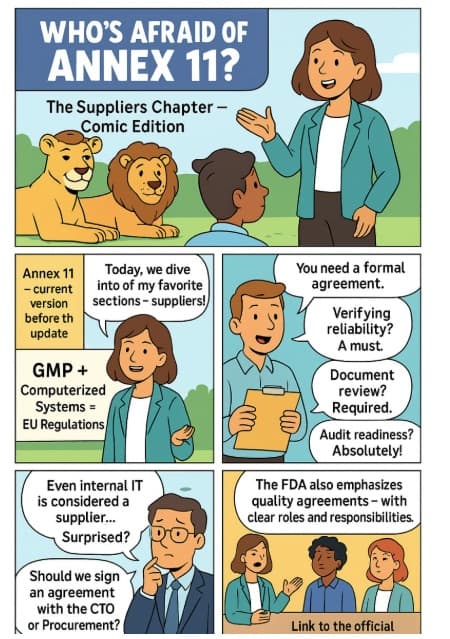#3 Who's afraid of Annex 11?

🧭 Risk Management in Computerized Systems – A Core Principle of Annex 11
Quality control in computerized systems requires a structured, risk-based approach. The regulator emphasizes that risk management must be integrated throughout the system lifecycle, considering patient safety, data integrity, and product quality.
In other words – from the very first stage of design to daily operation – risks must be identified, assessed, and mitigated.
💡 Yes, even before implementation begins – if you plan to introduce a new system, you are required to define the risks. Those definitions will drive your decisions regarding validation scope and the data integrity controls required.
The guideline stresses that risk management must rely on documented and justified assessments – not on assumptions or gut feelings. Organizations are encouraged to apply structured methodologies such as FMEA, ensuring that decisions are made through systematic analysis, prioritizing prevention over reaction.
💬 And no – the regulator doesn’t mandate a specific method. It only expects you to be able to justify your choice.
Applying these principles is not only a regulatory obligation – it’s a practical approach to ensuring data reliability and compliance. Organizations that invest in effective risk management reduce deviations and audit findings, while strengthening trust – both internally and with regulators.
If terms like Level of Risk, Residual Risk, or System Lifecycle are not part of your daily vocabulary yet – this is a good place to start. I’ll be happy to help you take that first step. 😃
Related Posts

How Do You Measure Integrity?
About eight years ago, I was asked a question that has stayed with me ever since. And today, in a completely different context, I found myself returning to tha...

#5 Who's afraid of Annex 11?
Annex 11 – Part 5 Or in other words: Another episode in the series "Who’s Afraid of Annex 11?" This time, we dive into one of the hottest topics among my collea...

#4 Who's afraid of Annex 11?
Annex 11 – Part 4 Or in other words: Another episode in the series "Who’s Afraid of Annex 11?" This time we focus on one of my favorite and most formative parag...